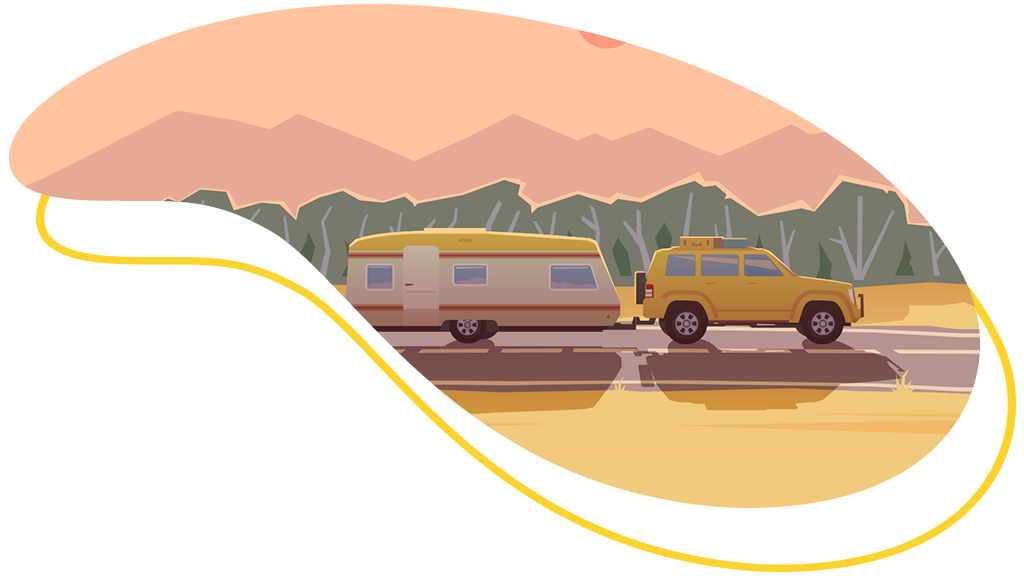Summer has come knocking and for many that means *cue Life is a Highway* – hitting the road! There’s a reason summer roadtrips make the best memories. Winding roads, small towns, incredible views, gas stations, special playlists, the GPS on and the wind in your face are just some of the best moments of a summer vacation.
And what better way to ensure all the freedom you want? That’s right! Just tossing your bags into an RV and hitting the road! With an RV, your accommodation goes with you wherever you go and it comes with the added bonus of being able to cook your own food, and the comfort– not to mention cleanliness– of your own bedroom and bathroom. Amazing, right?!
If only it were as easy as just throwing everything into an RV and driving off into the sunset. Unfortunately, for a trip that is truly leisurely and fun, it is essential that you plan ahead and make sure all your bases are covered. If that sounds complicated, we’re outlining all the steps along the way so that you can enjoy your next roadtrip of a lifetime!
First things first: do you own an RV?
This might sound like a silly question, but you don’t actually have to own your own trailer or motorhome to take that epic camping vacation trip you’ve always dreamed of. You have options!
There are several RV rental companies and even car-sharing companies where you can rent from someone who is not on vacation. Think: Airbnb for RVs and motorhomes.
If you’re planning to rent a trailer for your next trip, it’s a good idea to make sure you’re organized and booked in advance. The top recommendation is a motorhome of 30 feet or less, which will give you enough space and still “fit” in any campsite, public or private.
Do you know the kind of RV you need?
If you’re not familiar with the different types of RVs that exist, choosing one can be confusing. Here’s a quick overview:
Motorhomes are divided into three classes: Class A (think:bus), Class C (think: truck) and Class B (think: cargo van). Trailers come in all shapes and sizes, but most are divided into travel and fifth-wheel trailers.
Choosing the right type for you, your family and your trip will depend on many things. How many people will travel, whether or not you have a vehicle to tow the trailer, your comfort level, your destination, the total distance, and your financial conditions can all be deciding factors.
A C-Class RV rental will be similar to driving a truck that we rent for moving and is quite easy to maneuver on highways and parking lots. Smaller B-Classes are the size of a van and are even easier to drive, but offer very little storage or even sleeping space. Class A, on the other hand, are like buses and can scare first-time RVers, in addition, they are not accepted at all campsites.
Are you going to buy your first RV?
If you’re past the rental stage and are thinking about buying your first RV, make sure you buy one that suits your travel style. Consider assembly and disassembly times, access to fuel stops and quick breaks on the road.
Be sure to outline the type of camping experiences you want to have. As with renting, the recommendation is to buy a trailer that is less than 30 feet long to fit most available campgrounds.
If you’re the adventurous type who likes to park in free, unstructured spots every now and then, be sure to look for RVs with large tanks of fresh water, gray water, and black water. You can also include solar panels or an onboard generator to ensure power through the night.
Already own an RV?
If you’ve already bought your trailer and are eager to hit the road, get acquainted with your new home on wheels first. Drive into an empty parking lot and practice reversing, parking and turning. Create custom checklists for camp departures and arrivals. Measure and record the length and height of your equipment (including air conditioning). Load your trailer with all your gear and head to the nearest CAT scale to make sure it’s not over the weight limit.
6 steps for planning a successful RV trip
Let’s get to what matters! If you have arrived at this blogpost, you are probably already convinced that this is a great way to travel and enjoy the summer. But it’s always good to remember that challenges and concerns exist. No matter how experienced you are, there is still a lot to learn before hitting the road in an RV.
1. Choose the right RV for the trip you want to take
While the recommendations are for RVs under 30 feet, you may want more comfort, have a larger family, or are planning a longer trip and need more space to stock up on groceries.
Matching your gear to the adventure you want is the first step in planning a successful RV trip.
2. Make plans according to your budget
The three most expensive items for an RV trip are fuel, camping fees, and food. All three can vary drastically depending on the type of trip you plan. Draft routes, calculate fuel costs, take your food and check refueling locations on your way.
Remember, you don’t have to cross the country to have an amazing adventure. You can plan to spend a few days at amazing campsites and sleep a few nights in free parking lots, like a Walmart. Just don’t forget to check beforehand if you will need some kind of authorization to stay overnight in these places.
3. Book campsites in advance
The best state and national campgrounds are usually booked months in advance, so reservations are strongly recommended. Read the online reviews carefully, just as you would a hotel. Make sure the campground has the amenities you need, whether it’s a pool and hot tub or just clean bathrooms. Write down the cancellation policies and record them on your smartphone calendar along with the booking information. That way, you’re prepared if plans change while you’re on the road.
4. Plan a route that is suitable for RVs
Many seasoned roadtrippers love to explore secondary or alternate roads when traveling from point A to point B. You will have to approach route planning differently when taking an RV trip. Look for any restrictions for bridges and tunnels. Think about the fuel stops that your vehicle requires and be aware of inclines or other road conditions that can make your job behind the wheel more difficult.
5. Research RV parking in advance.
Experienced roadtrips love to find unexpected treasures and make unplanned stops. This becomes a little more complicated when traveling by RV. Call ahead to any areas of interest along your route and ask for parking details.
What about those fun, unplanned stops along the way? Check the GPS on your smartphone to see if the arrival and departure locations are RV friendly.
6. Adjust your arrival forecast.
There’s no point in calculating travel time based on your road experience driving a car. Travel time aboard a trailer or motorhome is much slower. A rule of thumb is to plan for an average route speed of 50 miles per hour.
Plus, driving an RV takes a lot more focus than driving a car, and driving fatigue can come sooner than you might anticipate. For this reason, some RVers follow the 3/300 rule: do not drive more than 300 miles in a single day and arrive at your destination no later than 3pm.
Time to pack!
It is essential to pack your bags in advance. This reduces stress and the chances of forgetting something important. To help, here are some basic lists that you can adjust per your needs.
The Basics
These may be a little different for everyone, but some of them can be considered essentials. If you are renting the vehicle, some may already be onboard, but a checklist is never a bad idea.
Kitchen items:
- cups and mugs
- plates
- bowls
- cutlery (forks/knives/spoons)
- napkins
- paper towels
- kitchen utensils (tweezers, large spoons, ladles, etc.)
- can opener
- bottle opener
- corkscrew
- coffee machine
- pans
- large pot
- pot holders
- dish towels
- sponges
- dish detergent
- ziploc bags
- plastic wrap/aluminum foil
- cleaning wipes
- plastic bowls
- matches and/or lighters
Health & Hygiene
- First aid kit
- alcohol and antiseptics
- pain relief medications
- medicine for motion sickness
- any other medications you may need
- hand soap
- face soap
- body soap
- loofah/scrub
- shampoo
- conditioner
- hair brush / comb
- hairdryer
- moisturizer
- toothpaste
- toothbrush
- dental floss
- mouthwash
- nail clippers
- cotton / cotton swabs
- sunscreen
- insect repellent
Outdoor equipment
- firewood (note that most states do not allow firewood to be transported across state lines)
- outdoor chairs/table
- binoculars
- Hiking pack
- fishing rod(s) and equipment
- sports equipment
- water bottles
- bicycles
- canoe or kayak, oars, life jackets
- Hiking poles
Miscellaneous
- pillows and pillowcases
- bedding
- towels
- extra blankets
- pet supplies
- sewing kit
- phone chargers
- laptop and laptop charger
- cleaning products
- broom/dustpan, vacuum cleaner, mop
- cash
- booking confirmation info
- board games
- books
- walkie talkie / radio
Emergency Kit
Every RV must have an emergency kit onboard. After all, if the worst happens, you’ll want to be prepared. An emergency can happen during bad weather, a car accident, a fire, etc., and these supplies can be life-saving. It’s nearly impossible to get all the essentials while an emergency is happening. For this reason, an emergency kit should already be assembled and placed near the front door of your RV or in an external storage compartment.
Food & water
- canned food or MREs
- protein bars
- water bottles
- water purification tablets, systems or straws
Medical supplies
- bandages
- gauze
- ointment for burns
- antiseptic wipes
- antibacterial wipes
- tape
- splint
- tweezers
- scissors
- pins
- hand sanitizer
- face masks
- thermometer
- first aid pocket guide
- Covid tests
Roadside equipment
- emergency warning triangles
- neon vest
- lights (also available in LED)
- tow straps
- traction mats
- tire chains
- jump starter
- air compressor
- spare tire
Miscellaneous
- extra clothes
- safety glasses
- high resistance gloves
- water resistant flashlight with additional batteries or LED flashlight
- whistle
- heavy duty pocket knife
- tools
- compass
- glass breaker/seat belt cutting tool (this should be kept close to the driver’s seat, not inside the kit)
- spare phone chargers and portable chargers
- emergency contact list with phone numbers, addresses and medical information
- copies of important documents (passports, insurance, etc.)
- extra pet food, a few extra days’ of medication, copies of veterinary records, etc.
When you break the planning down into stages, the task feels easier to manage. Since you’ll need advanced notice to make reservations and plan your route, pace yourself and start little by little and before you know it, you’ll be ready to hit the road.







